Here are a few tips that my crew and I have found very helpful when tying my boat in it’s slip.
Tying the boat to the dock seems to be taken for granted by many and not much thought put into it. Every boater has probably seen boats pull into their slip and as the dock lines are made fast to the cleats amidst much hand waving and “discussion” by the skipper about how to properly handle the dock lines.
All my dock lines have eyes on each end and the dock lines stay at the dock while we go sailing. The dock lines are then waiting when we return and mooring the boat is as simple as just dropping the eyes over the appropriate cleats and winch. Quick, easy and no confusion by the crew on where the boat goes and the boat is always moored in the proper place.
I had the marina add a second cleat (the one on the right side of the picture). Cleats should be properly through bolted, never use Lag Bolts to fasten a mooring cleat, Lag Bolts can pull out and the cleat can come loose, flying cleats can cause property damage or even injure people standing by a cleat that comes loose, your boat is now loose in the slip and your boat can be damaged as well as others in the marina. Using two cleats lets the bow of the boat be centered in the slip by the dock lines. I set the length of the lines to have the boat sitting a bit away from the dock so the fenders are not held against the dock (yes this is a tape measure distance).
Depending on your boat, equipment and marina you may need chafe gear on your boat to protect your lines.
Be careful when passing through the center of the cleat. Some cleats are not well finished in the center and require extra chafe gear in the base to prevent the line from being damaged. One cleat was so rough in the middle that the line was almost cut through in under two weeks when I forgot to check the base of the cleat.
This is the Stopping Strap. One end goes to the primary winch on the port side and the end at the top of the picture is dropped over the first cleat on the end of the dock. The Stopping Strap is to stop the boat before it hits the dock if I have a bad approach and enter the slip too fast, misjudge the speed, reverse does not work or any one of many things that can go wrong when entering a slip. The length of the Stopping Strap is set to stop the bow of the boat from hitting the dock. The extra length of line spliced into the eye is to make the line long enough that a crew member can step onto the dock at the shrouds and be able to hold onto the end of the line.
I use a Stopping Strap and not a regular dock line because no matter how many times I explained to crew members most of them, no matter how many times it was explained to them “don’t stop the boat early” they will dog down the line way early and stop the boat before it is in the slip ahead of my slowing the boat down. Also they will put the line on the wrong side of the cleat and the line will slip off the cleat as the boat goes by. Using a fixed length Stopping Strap with eyes on each end has reduced the confusion greatly.
I use the primary winch for several reasons. My boat only has three cleats. If the bow cleat is used, the bow of the boat will rotate into the dock fairly hard if the bow line is used to stop the boat and the stern will kick out away from the dock and toward the boat moored along side. The stern cleats will not stop boat boat before the bow hits the end of the slip. The primary winch has a good position for length and by being positioned in toward the center of the boat the tendency for the bow to swing into the dock is reduced.
I have several friends that use the mid-ship cleat on their power boat to stop forward motion when they are docking. They use the mid-ship cleat and not the bow cleat to reduce the bow into the dock problem when the dock line is used to stop the boat.
The cleat has orange surveyor tape on it as does the eye at the end of the Stopping Strap. When I have a crew member STEP (NOT JUMP) to the dock I tell them to put “Orange to Orange” this has gotten the success rate up to about 92% getting the Stopping Strap on the correct cleat.
The stern breast line is a bit undersized based on generally recommended sizes from the rope manufactures. I have done this to have better shock absorbing properties and the boat does not jerk suddenly when the slack is taken out of the line. CAUTION: The smaller sized line works in this application because the boat is light weight and the boat and marina are sheltered against strong off the dock winds. You should evaluate your own conditions carefully when selecting and sizing dock lines.
Your dock lines should be inspected on a regular basis and replaced when they show signs of wear or other problems. I wash mine yearly (Washing Your Sheets, Halyards and Lines) in mild soap and water to to remove dirt and salt crystals, help keep the lines from getting stiff and make line handling nicer to the hands. The dock lines are replaced every two years or so when they start to get stiff, loose some of their shock absorbing properties, start to show significant wear or other signs of deterioration.
Yes, I see very old dock lines that are so stiff I can’t understand how they got them to bend around the cleat but I am a bit more cautious.
Some people replace their dock lines annually, buying new lines when they are on sale as a loss leader at the local chandlery.
I use three strand line for the dock lines because three strand stretches more than double braid line giving a gentler movement to the boat at the dock which is easier on the cleats and anyone onboard the boat. Three strand eye splices are also easy for me to do myself.
I also have a full set of dock lines that stay on board for when I visit different marinas, the fuel dock, pump-out station or raft up with other boats.
As with all things related to boating, you need to assess your own situation and boating conditions and adjust your actions accordingly. What has worked for me might not work for you, please change things to fit your own needs. Please consider these ideas as a starting point and feel free to improve them to fit your own dock conditions.
Thanks for your interest in and support of boating safety.
Please see How to Tie Your Boat to a Dock That Has a Bull Rail – Part 1 for more information and instructions on tying your boat to a dock that has a Bull Rail.
Please see Chafe Protection – Or keeping your boat tied up in a storm for some tips on preventing chafe and damage to your lines.
The Towboat Hitch or Capstan Hitch, when you need a non-jamming tie to a single post, bit, bollard or sailboat winch.
How to Tie a Cleat Illustrated How to Tie a Cleat.
Useful knots to tie your fender with
Toe Rail Fender Knot, for boats with a perforated toe rail, Toe Rail Fender Knot.
Spar Hitch, holds well to slick and small rails.
An improved Fender Whip for fenders with a hole through the center, that holds knots much better than a standard Fender Whip.
Improved Fender Whip – Part 2 – for fenders that have a tab on the end for the fender whip to be attached to.
c/m


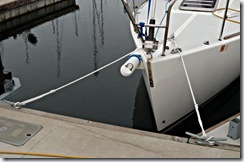
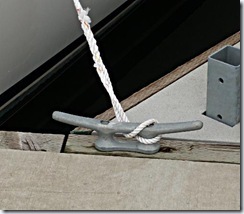

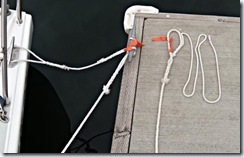

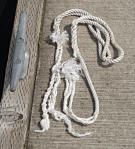
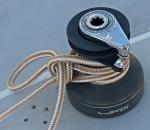
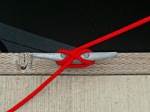
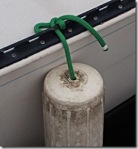
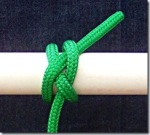





I can see how your system works for you. It seems however that it might be boat / vessel specific. I find that with a large vessel I require more flexibility with regards to length of dock line. I.E. eye on one end only. Docking is accomplished by using the breast line first. This will arrest the boats position in the event that the bow or sterns
movement away from the dock is limited. This also elevates the problem of having an inexperienced person on the dock hauling in on bow or stern line and causing a problem.
When docking the eye of the dock line is attached to the boat. A large loop is formed between both hands and several loops of free line held as when heaving any line. The bitter end is also kept on board. The section or loop is cast either in front of the dock cleat and the bitter end hauled in behind the cleat. Since the loop thrown has gone past the cleat when it is hauled in by it’s bitter end it will pull up and around the dock cleat. Haul in as the boat comes to the dock and make the center line fast. Now you have plenty of time to deal with the bow and stern at your leisure. Handling a vessel at 56,000 lbs and 59′ loa. has become second hand for myself and my wife. Help on the dock is always appreciated but with care to keep a close eye on the experience of those helping. As for leaving my lines on the dock. I take my lines with me in the event of theft or others slipping into my spot when I’m out.
Pingback: Is This Your Cleat? | Boating Safety Tips, Tricks & Thoughts from Captnmike
While an eye on each end may work if you have floating docks, if they’re fixed docks, not so well… I live aboard at a marina on the Chesapeake, and numerous times I’ve retied boats that were unexpectedly bashing up against a piling due to strong winds/low/high tide combinations. If a proper cleat hitch has been used on both the dock and boat cleats, with a bit of line left over, it’s easy and safe for me to adjust the line for the conditions that the owner did not see coming. But if they’re eye’s like you suggest, then there’s often nothing I can do, except watch a pretty boat get a bad case of (expensive) pile rash. A simple whipping or marking on the dock line where the owner expects the line to bend onto the boat cleat still allows the crew to quickly and accurately set it.
Yes I am on a floating dock. If I was in an area where the water level went up and down and the dock did not (Lake Washington & Lake Union here in Seattle) I would use your suggestion and have the eye on the boat and a regular cleat hitch at the dock with enough extra line to adjust for the change in water level. Yes I would make it easy for you to help keep my boat safe if the weather and water conditions change.
Thanks for stopping by. My former dock captain and his wife lived on the Chesapeake for several years and said the tides were so small they never looked at a tide table but they ALWAYS checked the wind direction as the wind caused the water to go up and down more than the tide. As always, local knowledge is good, making friends with people in an area that is new.
We tried the stopping strap for the first time yesterday and it worked really well. I’m keeping a hard dinghy on the dinghy rack at the end of my dock, and the difference between “too far” and “not far enough” when docking is about 1 foot (29′ boat in a 30′ slip). Your stopping strap works well.
Was Shilshole pretty open to adding that second cleat by the corner of the dock and the finger slip? That would be very helpful for my boat too.
I also like how you pass the loop through the eye of the cleat.
Glad the stopping strap worked – you are at least the second convert on S dock – Today S dock – Tomorrow the world 🙂
Adding the cleat is easy – but you need to have the marina add it for you, putting your own cleat (or any holes in the wood even I think) is against the rules (part of it is a liability issue, if you don’t put the cleat in correctly and then you move to another slip and the cleat comes loose for the next boat owner it would be a mess) – you just need to ask the marina to add it and pay for the cost, sorry I don’t remember the cost. I think this is the third cleat I have bought from Shilshole. You will need to meet with one of the maintenance people and show them where you want the cleat or make a very very clear sketch. I made a sketch and the office accepted it so I did not need to meet with the maintenance people.
Then a week or so later the cleat showed up like magic.
Just a hint. There wet docks and dry docks. Our craft sit in docks. We tie them to piers, wharfs, quay walls, etc. but not to docks.
Yes the part about a dock being between two piers – ran into that in a class a few months ago – and yes it tripped me up a bit
Thanks & have a nice week
Nice share captnmike! This is very important for a newbie in boating like me. Thanks
You are welcome, glad this helped
good luck with your intro to boating
Pingback: Diving and Seamanship - Page 8
My wife and I (often me alone) frequently sail to other marinas here on the Great Lakes (there are many). I prefer to not use the crutch of dedicated length dock lines. Instead I *always* adjust my dock lines for each new docking situation. Even at my own slip at my home marina.
I use the fixed length at my slip, when I tie up at other piers I usually use a standard mooring line, I will at times like you put a loop in the end for an appropriate length.
One friend with a power boat, cruises mostly just with his wife uses a fixed length line to a mid-ships cleat on their boat and the loop on the end is long enough to get back to the aft quarter of their boat with some left over, her job is to get the end of the line to the cleat, his job is to get the boat close enough to the cleat for her to easily drop the loop over the cleat on the pier. Then they adjust or change the mooring lines to match the situation.
The loop on the end of the line is to make the cleat easier to tie to, as you note, things change and a good boater adjusts to the specific situation.
thanks for dropping by and sharing